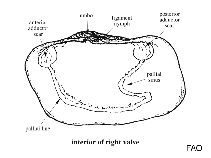Panopea generosa (Gould, 1850)
Pacific geoduck| Native range | All suitable habitat | Point map | Year 2050 |

|
| This map was computer-generated and has not yet been reviewed. |
| Panopea generosa AquaMaps Data sources: GBIF OBIS |
Google image | No image available for this species;
drawing shows typical species in Hiatellidae.
Classification / Names Common names | Synonyms | CoL | ITIS | WoRMS
Bivalvia | Adapedonta | Hiatellidae
Environment: milieu / climate zone / depth range / distribution range Ecology
Benthic; depth range 0 - 110 m (Ref. 865). Temperate; 61°N - 26°N, 146°W - 112°W (Ref. 104413)
Distribution Countries | FAO areas | Ecosystems | Occurrences | Introductions
Eastern Pacific: From Alaska to Baja California. Subtropical to temperate.
Length at first maturity / Size / Weight / Age
Maturity: Lm ? range ? - ? cm Max length : 17.5 cm SHL male/unsexed; (Ref. 865); max. reported age: 100 years (Ref. 8702)
Life cycle and mating behavior Maturity | Reproduction | Spawning | Eggs | Fecundity | Larvae
Main reference
References | Coordinator | Collaborators
Pacific Northwest Shell Club 2014 Pacific Northwest marine molluscan biodiversity. Pacific Northwest Shell Club, www.PNWCS.org. http://www.bily.com/pnwsc/web-content/Northwest%20Marine%20Molluscan%20Biodiversity.html [Accessed 06/02/2014]. (Ref. 94906)
IUCN Red List Status
(Ref. 130435: Version 2025-1)
CITES status (Ref. 108899)
CMS (Ref. 116361)
Threat to humans
Human uses
Fisheries: commercial
| FishSource |
Tools
More information
Max. ages / sizes
Length-weight rel.
Length-length rel.
Length-frequencies
Mass conversion
Abundance
Internet sources
BHL | BOLD Systems | CISTI | DiscoverLife | FAO(Publication : search) | Fishipedia | GenBank (genome, nucleotide) | GloBI | Gomexsi | Google Books | Google Scholar | Google | PubMed | Tree of Life | Wikipedia (Go, Search) | Zoological Record



